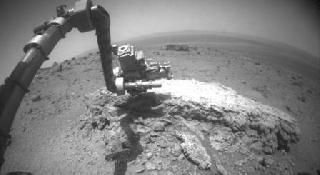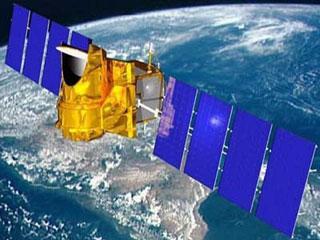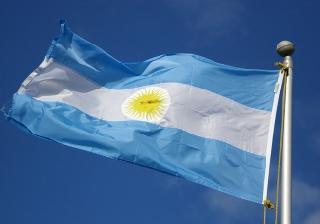
NASA's Mars Exploration Rover Opportunity used its front hazard-avoidance camera to take this picture showing the rover's arm extended toward a light-toned rock. Photo by NASA/JPL-Caltech.
PASADENA, CALIFORNIA (BNS): Mars rover Opportunity's initial work at its new location on the Red planet has shown surface compositional differences from anything the robot has studied in its first 7.5 years of exploration.
The first rock it examined upon arrival at the crater named Endeavour three weeks ago is flat-topped and about the size of a footstool, NASA said.
The rock informally named "Tisdale 2" is different from any rock ever seen on Mars, said Steve Squyres, principal investigator for Opportunity.
"It has a composition similar to some volcanic rocks, but there's much more zinc and bromine than we've typically seen. We are getting confirmation that reaching Endeavour really has given us the equivalent of a second landing site for Opportunity," he said.
In the past two weeks, researchers have used an instrument on the rover's robotic arm to identify elements at several spots on Tisdale 2. Scientists have also examined the rock using the rover's microscopic imager and multiple filters of its panoramic camera.
Observations by Mars orbiters suggest that rock exposures on Endeavour's rim date from early in Martian history and include clay minerals that form in less-acidic wet conditions, possibly more favorable for life.
They said discontinuous ridges are all that remains of the ancient crater's rim. The ridge at the section of the rim where Opportunity arrived is named "Cape York." A gap between Cape York and the next rim fragment to the south is called "Botany Bay."
The science team selected Endeavour as Opportunity's long-term destination after the rover climbed out of Victoria crater three years ago.
 Previous Article
Previous Article Next Article
Next Article












The Indian Air Force, in its flight trials evaluation report submitted before the Defence Ministry l..
view articleAn insight into the Medium Multi-Role Combat Aircraft competition...
view articleSky enthusiasts can now spot the International Space Station (ISS) commanded by Indian-American astr..
view article